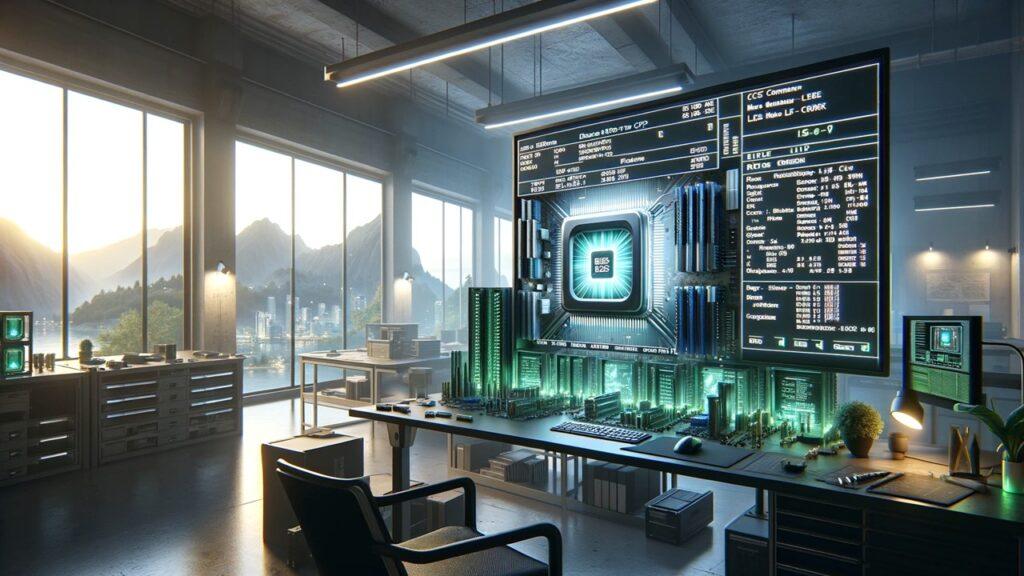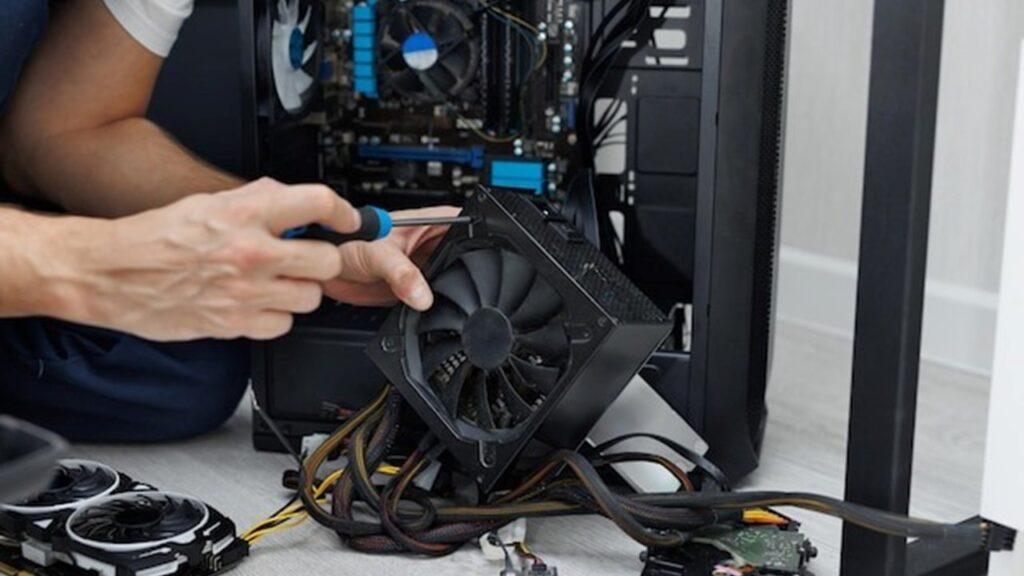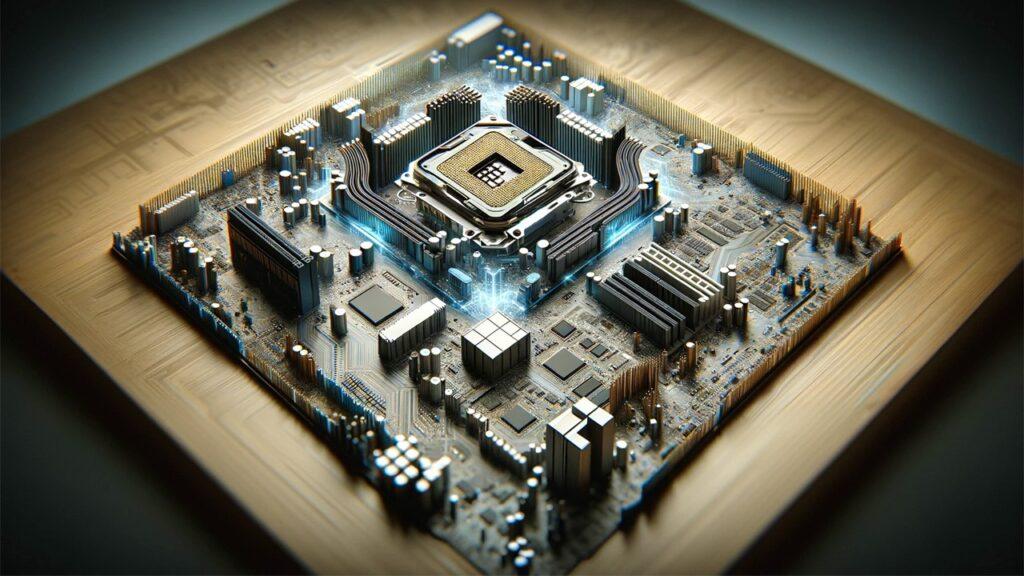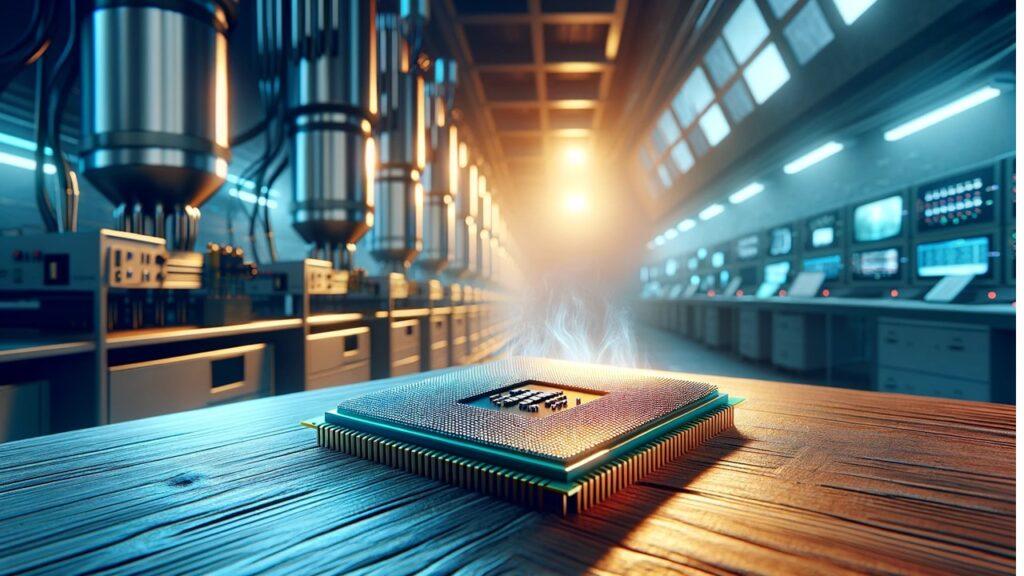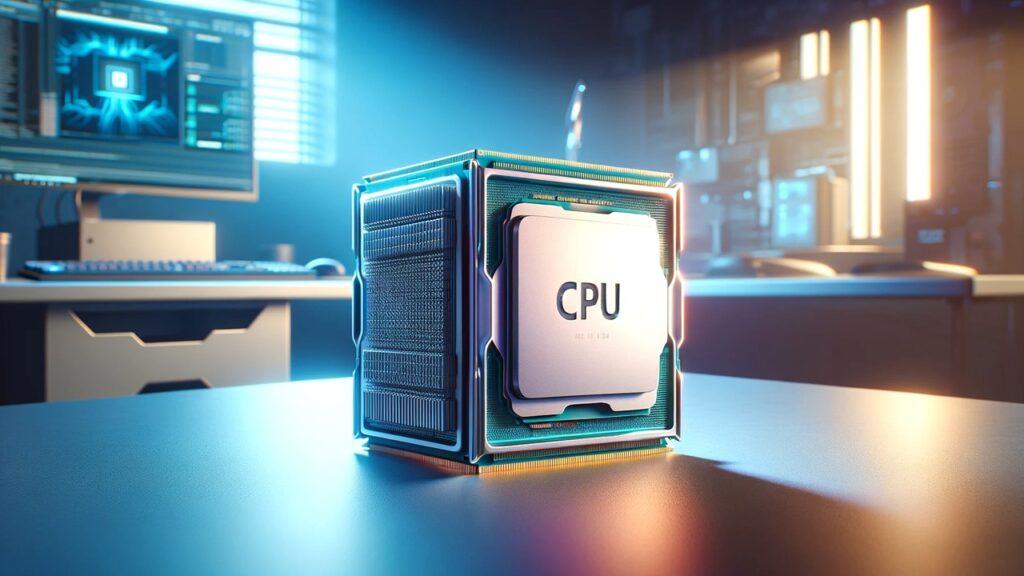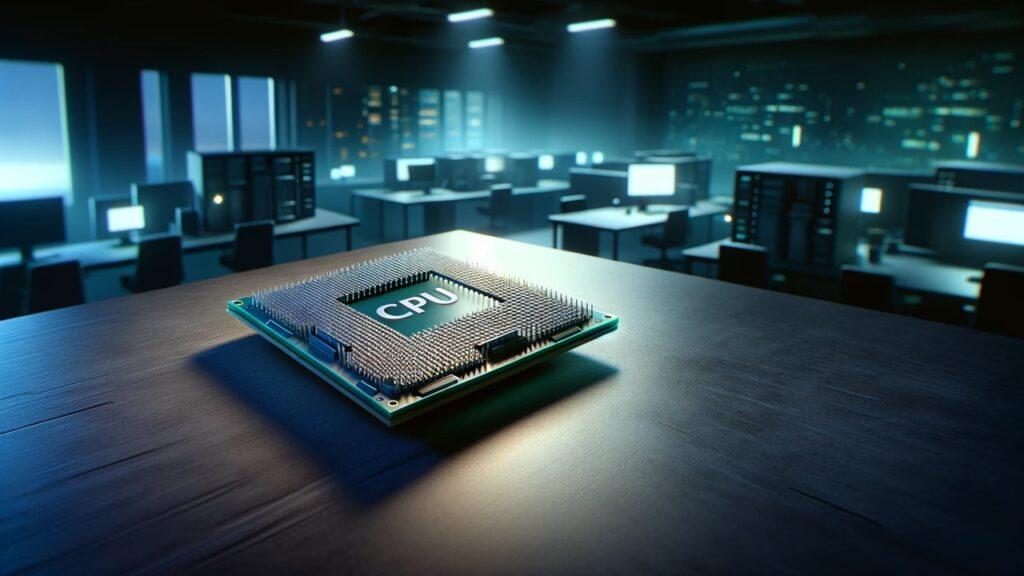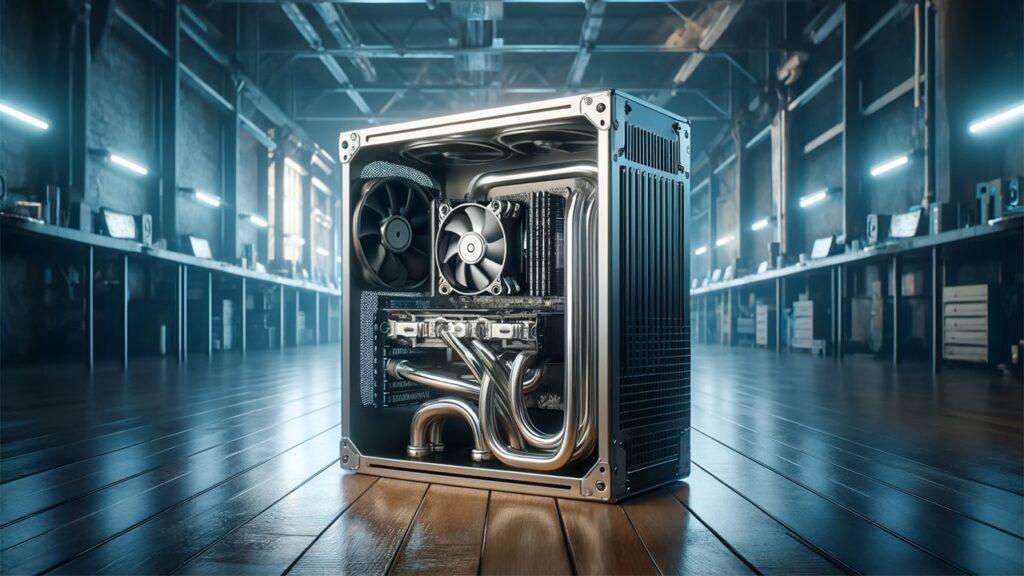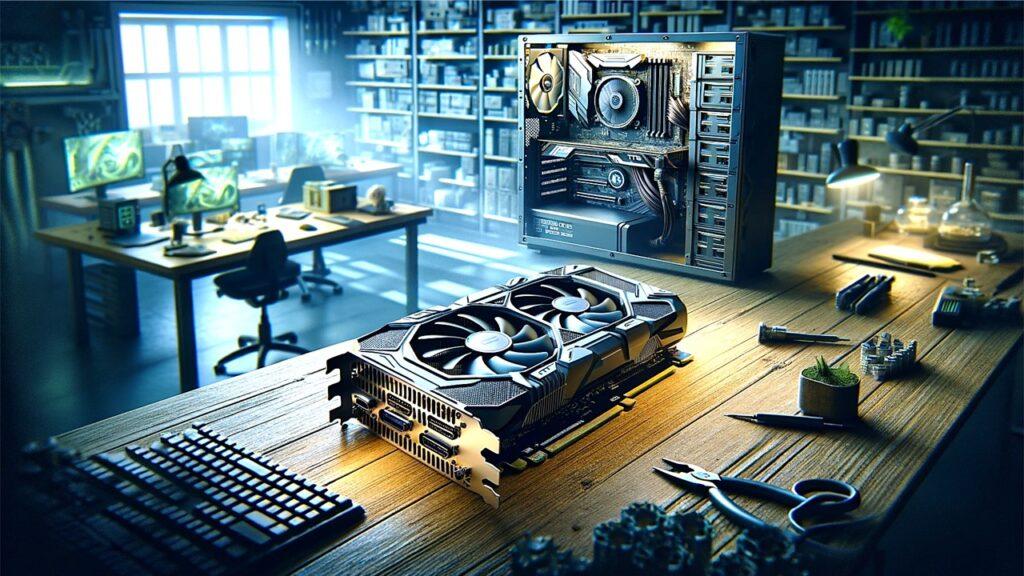Editing 4K video on a budget? These 5 budget-friendly graphics cards for 4K video editing in 2025 deliver smooth performance and quality rendering, without a hefty price tag.
We’re reader-supported. When you buy through links on our site, we may earn an affiliate commission. As an Amazon Associate, we earn from qualifying purchases.
Best Budget Graphics Cards for 4K Video Editing: Our Top 5 Picks
1. Best Overall Option: MSI Gaming GeForce RTX 3060
2. Best Value Option: XFX Speedster QICK319 Radeon RX 6750XT
3. Best CUDA Acceleration Option: ZOTAC Gaming GeForce RTX 3060 Ti
4. Best Versatile Option: PowerColor Fighter AMD Radeon RX 6600
5. Best Most Efficient Option: GeForce GTX 1660 Super
1. Best Overall Option: MSI Gaming GeForce RTX 3060

Quick Specifications
- Manufacturer: MSI
- GPU: NVIDIA GeForce RTX 3060
- Cooling System: Torx Twin Fan
- Memory Capacity: 12 GB GDDR6
- Energy Consumption: Moderate
- Boost Clock Speeds: 1807 MHz
- Connection Interface: HDMI 2.1, DisplayPort x 3 (v1.4a)
- Processing Units: Enhanced Ray Tracing Cores and Tensor Cores
In our experience, the MSI Gaming GeForce RTX 3060 emerges as a cornerstone for budget-friendly yet high-performance 4K video editing PC builds. Furthermore, this graphics card offers a harmonious blend of advanced features like the Ampere architecture and generous 12 GB GDDR6 memory, making it a reliable choice for creative professionals. Moreover, its ability to handle the latest games translates seamlessly into superior video editing capabilities, ensuring smooth rendering of high-resolution content.
Furthermore, the twin fan cooling system is a testament to MSI’s commitment to maintaining optimal performance under heavy workloads, which is crucial for lengthy video editing sessions. The versatility of its connection interface, including multiple DisplayPort and HDMI options, provides ample flexibility for multi-monitor setups or high-resolution outputs.
Pros:
- Robust 12 GB GDDR6 memory caters to demanding 4K video editing needs.
- Advanced cooling system ensures sustained performance.
- Versatile connection interfaces offer flexibility in setup configurations.
- High-resolution support up to 7680 x 4320 maximizes editing precision.
Cons:
- The size may challenge smaller PC cases, requiring careful planning.
- Energy consumption can be a consideration for those with power-sensitive setups.
From our standpoint, the MSI Gaming GeForce RTX 3060 represents an excellent choice for those seeking to elevate their 4K video editing without breaking the wallet. Its balance between cost, capabilities, and cooling efficiency positions it as a standout option in our list. Furthermore, with its solid performance, future-proof features, and compatibility with the latest video editing software, it’s clear why this graphics card is the proper cornerstone for any high-quality, budget-conscious 4K video editing PC build in our opinion.
2. Best Value Option: XFX Speedster QICK319 Radeon RX 6750XT

Quick Specifications
- Manufacturer: XFX
- GPU: AMD RX 6750 XT
- Cooling System: XFX QICK 319 Triple Fan
- Memory Capacity: 12 GB GDDR6
- Energy Consumption: Efficient
- Boost Clock Speeds: Up to 2600MHz
- Connection Interface: HDMI, 3xDP
- Processing Units: Advanced RDNA 2 architecture
In our collective journey to discover the ideal blend of price and performance for 4K video editing, the XFX Speedster QICK319 Radeon RX 6750XT stands out as a beacon of value. Boasting 12 GB of GDDR6 memory and the prowess of AMD’s RDNA 2 architecture, this graphics card is more than equipped to handle the rigors of high-resolution video editing. Its triple fan cooling system ensures that even the most demanding tasks are conducted in a whisper-quiet and cool environment.
Moreover, the boost clock speeds of up to 2600MHz signify that this card is not just about raw power but also about delivering smooth, efficient performance across a range of editing software. The inclusion of multiple DisplayPort outputs alongside HDMI enhances its versatility, making it a suitable fit for varied editing setups.
Pros
- Exceptional memory capacity supports intensive 4K editing workflows.
- Triple fan cooling keeps temperatures low during heavy usage.
- High boost clock speeds ensure snappy performance and quick render times.
- Efficient energy consumption makes it a sustainable choice for long-term use.
Cons
- Its size may be cumbersome for compact PC cases, requiring space management.
- The initial setup could be slightly complex for novice users, but manageable.
From our perspective, the XFX Speedster QICK319 Radeon RX 6750XT encapsulates what it means to offer real value in the realm of 4K video editing. Not only does it boast features that rival more expensive models, but it also maintains a price point that respects the budget-conscious buyer. Furthermore, it’s this harmonious balance between cost, capability, and cooling efficiency that positions it as an excellent choice in our roundup. Perfect for those looking to push their creative limits without pushing their budget, it represents a savvy investment for any serious video editor in our opinion.
3. Best CUDA Acceleration Option: ZOTAC Gaming GeForce RTX 3060 Ti

Quick Specifications
- Manufacturer: ZOTAC
- GPU: NVIDIA GeForce RTX 3060 Ti
- Cooling System: IceStorm 2.0 Advanced Cooling
- Memory Capacity: 8 GB GDDR6
- Energy Consumption: High Efficiency
- Boost Clock Speeds: 1695 MHz
- Connection Interface: DisplayPort x 4, HDMI 2.1
- Processing Units: 2nd Gen Ray Tracing Cores, 3rd Gen Tensor Cores
In our journey to find the most suitable graphics card for CUDA acceleration within a budget, the ZOTAC Gaming GeForce RTX 3060 Ti has proven to be a standout performer. It combines the NVIDIA Ampere architecture’s power with a reasonable price tag, making it a compelling choice for 4K video editors who rely on CUDA-accelerated applications. Its advanced cooling system and efficient energy consumption further bolster its appeal, providing a smooth and cool operation even under heavy loads.
Moreover, the ZOTAC GeForce RTX 3060 Ti is not just about brute force. It offers a thoughtful balance of performance and features, such as white LED logo lighting for aesthetic appeal and a robust metal backplate for added durability. With support for up to 8K resolution and four displays, it’s an excellent option for multi-tasking video editors who demand high fidelity and versatility from their setups.
Pros
- Outstanding CUDA acceleration enhances performance in video editing software.
- Advanced cooling technology keeps the card operating quietly and efficiently.
- Supports multiple displays for an expansive workstation setup.
- Aesthetic design with white LED lighting complements any PC build.
Cons
- 8 GB of memory may limit some high-resolution editing tasks.
- Slightly higher energy consumption compared to other models in its class.
In our list, the ZOTAC Gaming GeForce RTX 3060 Ti emerges as an excellent choice for 4K video editors in need of CUDA acceleration without overspending. Moreover, its blend of power, efficiency, and cooling technology offers a solid foundation for any video editing PC build. In our opinion this graphics card’s capabilities make it a wise investment for creatives seeking to enhance their editing workflow with accelerated processing and high-quality outputs.
4. Best Versatile Option: PowerColor Fighter AMD Radeon RX 6600

Quick Specifications
- Manufacturer: PowerColor
- GPU: AMD Radeon RX 6600
- Cooling System: Efficient Air Cooling
- Memory Capacity: 8 GB GDDR6
- Energy Consumption: Optimized for Efficiency
- Boost Clock Speeds: 2491Mhz
- Connection Interface: 1 x HDMI 2.1, 3 x DisplayPort 1.4
- Processing Units: 1792 Stream Processors
In our search for the most versatile graphics card suitable for 4K video editing, the PowerColor Fighter AMD Radeon RX 6600 has emerged as a frontrunner. Addutionally, its robust blend of memory capacity, boost clock speed, and an efficient cooling system makes it an outstanding option for creators who need a reliable and versatile PC build. With a game clock speed of 2044Mhz and the capability to boost up to 2491Mhz, this card ensures smooth editing and rendering of 4K content.
Furthermore, the AMD Radeon RX 6600 by PowerColor is designed with the future in mind. Its multiple connection interfaces, including HDMI 2.1 and DisplayPort 1.4, allow for a wide range of monitor setups. This flexibility is essential for video editors who rely on multiple displays for their workflows. Moreover, its energy efficiency ensures that your editing rig maintains optimal performance without unnecessary power consumption.
Pros
- Highly versatile connection options cater to various monitor setups.
- Efficient cooling system keeps the card at optimal temperatures.
- Optimized energy consumption reduces power bills and environmental impact.
- Impressive boost clock speeds ensure smooth 4K video editing and rendering.
Cons
- 8 GB memory may need supplementation for extremely heavy 4K projects.
- Larger physical size could pose installation challenges in compact cases.
In our roundup, the PowerColor Fighter AMD Radeon RX 6600 claims its place as an excellent choice for video editors seeking versatility without breaking the wallet. Furthemore, its balanced performance, combined with the adaptability to various PC setups, makes it a reliable component of any 4K video editing build. In our opinion, this graphics card embodies the right mix of performance, efficiency, and versatility, making it a crucial part of our curated list for those who prioritize a seamless editing.
5. Best Most Efficient Option: GeForce GTX 1660 Super

Quick Specifications
- Manufacturer: ZER-LON
- GPU: NVIDIA GeForce GTX 1660 Super
- Cooling System: Dual Freeze Fans with Copper Powder Sintered Composite Heat Pipes
- Memory Capacity: 6 GB GDDR6
- Energy Consumption: Optimized for Low Power Use
- Boost Clock Speeds: 1785 MHz
- Connection Interface: HDMI, DisplayPort, DVI
- Processing Units: High-Performance Turing Architecture Cores
From our extensive analysis, the GeForce GTX 1660 Super has established itself as an incredibly efficient choice for 4K video editing within a budget. Its 6GB of GDDR6 memory and Turing architecture offer excellent performance for video editing tasks, ensuring smooth playback and rendering of 4K content. Moreover, its energy efficiency not only reduces operational costs but also contributes to a greener computing environment.
Furthermore, the innovative cooling system of the GTX 1660 Super, featuring dual freeze fans and advanced heat pipes, maintains optimal temperatures even under heavy loads. This not only enhances performance stability but also extends the lifespan of the card. Its support for up to 8K display and ability to connect three monitors simultaneously offers exceptional versatility for editing suites.
Pros
- Superior energy efficiency keeps power consumption in check.
- Advanced cooling technology ensures the GPU runs cool and quiet.
- Supports multi-display setups for an expanded editing workspace.
- Turing architecture provides excellent performance for 4K video editing.
Cons
- 6 GB of memory might limit performance in more intensive 4K tasks.
- Physical size could pose challenges for smaller PC cases.
In our curated list, the GeForce GTX 1660 Super shines as an excellent choice for editors looking for efficiency and reliability. Its balance between power consumption and performance, coupled with an effective cooling system, makes it a standout option for anyone prioritizing a seamless 4K video editing experience. In our opinion, this graphics card aligns with our ethos of providing high-quality recommendations that don’t just chase after the latest trends but instead offer real, tangible benefits to the end-user, making it a proper fit for our selection.
Graphics Cards in 4K Video Editing PC Builds
In the dynamic realm of digital content creation, selecting the right graphics card for your 4K video editing PC build is pivotal. As the demand for high-resolution video content skyrockets, so does the necessity for powerful yet budget-friendly PC setups that can handle the intensive workloads of 4K video editing. This segment of our comprehensive guide focuses on understanding the critical role of graphics cards in video editing and how to navigate budget constraints when building a PC tailored for this purpose.
Graphics Cards in 4K Video Editing PC Builds
The heart of a 4K video editing PC setup lies not just in its CPU but significantly in its graphics card. This component is crucial for rendering and playing back high-resolution video smoothly, making the choice of a graphics card a key factor in a PC build tailored for 4K video editing.
Role of Graphics Cards in Video Editing
Graphics cards are instrumental in the world of 4K video editing, not just for their capability to render graphics but for their impact on overall workflow efficiency. A potent GPU accelerates rendering times, improves playback quality, and ensures that video editors can work on complex timelines without lag. With features like CUDA cores (for NVIDIA cards) or Stream Processors (for AMD cards), graphics cards significantly shorten the time it takes to render videos, apply effects, and encode files. Moreover, the GPU’s VRAM is critical, as higher memory allows for smoother handling of 4K footage and complex layers within projects.
Budget Constraints and PC Building
Navigating budget constraints while aspiring for a high-performance 4K video editing PC build can seem daunting. However, understanding which specifications matter most can guide you to make cost-effective choices without compromising on essential performance. Investing in a budget graphics card that offers a high memory bandwidth, sufficient VRAM, and robust processing power can provide a solid foundation for your PC setup. Balancing your budget means prioritizing components that will have the most significant impact on your video editing tasks, with the graphics card often being the place to allocate a larger portion of your budget.
The journey to assembling the perfect 4K video editing PC build within a budget is both challenging and rewarding. The graphics card emerges as a central figure in this quest, driving both performance and productivity. Moreover, by focusing on key specifications and making informed decisions within budget constraints, creators can unlock the potential of their PC setups to produce stunning 4K content. As the landscape of video editing continues to evolve, keeping abreast of the latest in graphics card technology will ensure that your PC build remains a powerful tool in your creative arsenal.
Do You Need Budget Graphics Cards for 4K Video Editing PC Builds?
The simple answer is, unequivocally, yes. The demands of 4K video editing require a graphics card that is both powerful and reliable. However, this doesn’t imply a need for the priciest option on the shelf. The market today offers budget graphics cards that are engineered to meet the hefty demands of 4K video editing, offering essential features such as considerable memory bandwidth, strong processing power, and swift rendering capabilities, all crucial for managing 4K content.
Moreover, the optimal budget graphics card elevates your PC build, tailor-fitting it for the rigors of video editing. It’s about striking a perfect balance where affordability aligns with necessary performance specs. Nowadays, budget graphics cards impress with features that rival those of more expensive models, including superior cooling systems, ample VRAM, and multi-display support.
Incorporating a budget graphics card into your 4K video editing PC build is a smart financial and operational move. It ensures that your setup is not just cost-effective but also robust enough to handle demanding 4K projects. Moreover, choosing the right graphics card is a strategic step towards empowering your content creation process, offering a blend of efficiency and economy that keeps your creative workflow smooth and uninterrupted.
Crafting a 4K video editing PC build on a budget is a delicate balance between cost and capability. The cornerstone of such a build is undeniably the graphics card, a component that can significantly elevate or limit your video editing prowess. This guide is tailored to help you navigate the myriad options available, pinpointing a budget graphics card that doesn’t just fit your wallet but also packs the punch needed for high-resolution video editing tasks.
How To Choose The Right Budget Graphics Card for 4K Video Editing PC Build
Finding the perfect budget graphics card for your 4K video editing PC build is an essential step towards achieving optimal performance without overspending. With an array of options available in the market, pinpointing the right card involves a detailed examination of specific features and performance indicators. Furthermore, this guide aims to shed light on the critical factors you should consider and how to accurately assess the value a graphics card brings to your editing suite, ensuring your selection supports your creative projects efficiently and economically.
Key Specifications To Consider
Initially, Memory Bandwidth and Type emerge as crucial factors. They determine the card’s capacity to handle the intense data flow of 4K content. Opting for a card with a high memory bandwidth and modern GDDR6 memory can significantly elevate your system’s ability to swiftly edit and render high-resolution footage, ensuring a fluid editing process.
Additionally, the Core Count and Clock Speed are paramount in assessing a card’s performance capability. A higher core count facilitates enhanced parallel processing, vital for quick rendering and managing complex edits efficiently. Similarly, a superior clock speed boosts the responsiveness of your system, accelerating the editing and previewing processes.
Furthermore, the importance of Connectivity and Compatibility cannot be understated. Ensuring that the graphics card seamlessly integrates with your system’s motherboard and fits within your PC’s case while providing the necessary ports for your display setup is critical for a hassle-free video editing environment.
Evaluating Performance Within Budget Constraints
Evaluating a graphics card’s performance within your budget involves looking at Performance Benchmarks. Moreover, these benchmarks give you a clear comparison of how different cards perform in tasks specific to video editing, allowing you to see which ones offer the smoothest performance for 4K content.
Moreover, considering the Price-to-Performance Ratio is vital. This metric helps you identify which graphics card offers the best value for its cost, ensuring you invest in a card that significantly improves your video editing workflows without unnecessary expenditure.
Selecting a budget graphics card for your 4K video editing PC build is a thoughtful process that balances technical needs with financial reality. Moreover, by focusing on essential specifications like memory bandwidth and core count, and evaluating how well a card meets your performance needs against its cost, you can make a well-informed decision.
This approach not only guarantees a graphics card that meets your current 4K editing requirements but also secures an investment that supports your creative pursuits efficiently and effectively, allowing you to produce high-quality content within your budget constraints.
Building Your 4K Video Editing PC Setup with a Budget Graphics Card
Embarking on the quest to assemble a 4K video editing PC setup within a budgetary framework is an intricate endeavor. It demands not just a keen eye for deals but a deep understanding of how each component’s performance impacts your editing workflow. This task goes beyond mere cost-cutting; it’s about constructing a harmonized, powerful workstation that can effortlessly manage 4K content, all while keeping your expenditure in check. Below, we explore the essential strategies for developing a video editing suite that perfectly balances affordability with stellar performance.
Selecting the Right Components
At the core of an efficient 4K video editing PC is the dynamic duo of the processor and graphics card. Identifying a processor and a budget-friendly graphics card that work in perfect concert is crucial. This combination ensures your system is well-equipped to tackle intensive editing tasks smoothly, offering a lag-free experience. Furthermore, this balance is instrumental in maintaining a fluid editing process, crucial for complex 4K projects.
Additionally, the significance of memory and storage cannot be overstated. Sufficient RAM is essential for seamless multitasking and handling hefty video files with ease. Moreover, a strategic blend of SSD and HDD storage solutions optimizes your system’s speed and storage capacity. This approach not only accelerates your operating system and applications but also provides ample space for extensive video libraries.
Assembling Your PC Build for 4K Editing
The assembly phase marks the transition from planning to execution. Precision and careful attention to compatibility and placement ensure each component contributes to a robust and efficient video editing workstation. Furthermore, a well-assembled PC forms the foundation of a stable and high-performing editing platform, indispensable for 4K content creation.
Optimizing Your Setup for 4K Video Editing
Optimization is the finishing touch that unlocks your PC’s true editing prowess. Up-to-date drivers, software settings tailored for video editing, and optimized system preferences enhance your PC’s performance. Additionally, these tweaks ensure your machine fully leverages its capabilities, enabling a focused, efficient editing workflow.
The journey to create a 4K video editing PC setup with a budget graphics card is a thoughtful blend of strategic component selection and system optimization. By carefully choosing components that complement each other, assembling them with precision, and implementing targeted optimizations, you construct not just a cost-effective system but a powerful, future-proof editing workstation. This approach not only meets your immediate editing requirements but also positions your setup for longevity and scalability, ready to bring your creative 4K visions to vivid life.
Navigating The Market: A Look at Budget Graphics Card Options
In the evolving world of digital content creation, finding the perfect budget graphics card for 4K video editing PC builds presents a unique challenge. The market is saturated with options, each boasting features that cater to various needs and budgets. This article navigates through the current landscape, offering insights into market trends, helping you make an informed choice based on features versus needs, and guiding you through the process of upgrading your PC build for 4K editing. The quest for the ideal budget graphics card involves more than just comparing prices; it requires a deep dive into the market, an understanding of evolving trends, and a keen sense of how to match a card’s features with your specific editing requirements.
Overview of Current Market Trends
Currently, the graphics card market is witnessing rapid advancements in technology, with a significant emphasis on providing high-quality video editing capabilities at budget-friendly prices. Moreover, brands are focusing on offering cards with higher memory capacities, better cooling solutions, and more efficient power consumption rates to cater to the demands of 4K video editors. Understanding these trends is crucial for identifying a card that not only fits within your budget but also meets your editing needs.
Making an Informed Choice: Features vs. Needs
Choosing the right graphics card for your 4K video editing PC build hinges on a delicate balance between the features offered and your specific editing requirements. It’s essential to prioritize features that directly impact your workflow, such as memory bandwidth, core count, and support for multiple displays. Moreover, this section delves into how to evaluate these features, ensuring that your chosen card optimally supports your 4K video editing endeavors without unnecessary expenditure on superfluous capabilities.
Upgrading Your 4K Editing PC Build
For those looking to upgrade their PC build for enhanced 4K editing performance, this segment offers a roadmap. Furthemore, it covers the critical considerations for upgrading, including compatibility checks, balancing new components with existing ones, and ensuring that your system remains balanced. A well-planned upgrade can significantly boost your editing efficiency and quality, allowing you to tackle more complex projects with ease.
The budget graphics card market for 4K video editing requires a nuanced understanding of current trends, a clear assessment of your editing needs versus the features available, and strategic planning for future upgrades. Armed with this knowledge, you can create a PC build that not only fits your budget but also powerfully supports your creative workflow, ensuring that you can bring your 4K video projects to life with stunning clarity and precision.
Maximizing Your Budget for 4K Video Editing PC Builds
Achieving the perfect balance between cost and capability in a 4K video editing PC build is a nuanced endeavor. Moreover, this journey involves strategic planning and making informed decisions that go beyond mere cost-saving. Furthermore, it’s about investing wisely in components like graphics cards, optimizing your setup with the right software, and applying practical DIY methods to enhance system performance. Each step taken towards economizing should not compromise the quality and efficiency required for professional-grade video editing.
Smart Shopping Strategies for Graphics Cards
In the quest for the best budget graphics card for 4K video editing, smart shopping techniques are indispensable. It’s essential to keep an eye on market trends, sales periods, and the availability of high-quality used or refurbished cards. Anticipating price reductions following new releases can also lead to significant savings. Furthermore, knowledge is power here, as understanding the specifications that matter most for 4K editing can help you spot great deals on cards that deliver the performance you need without overpaying.
Leveraging Free and Open-Source Software
Reducing costs on the software front is another effective strategy for budget-conscious PC builders. The realm of free and open-source video editing software presents a treasure trove of options that rival paid software in functionality. These tools not only cut down expenses but also foster a collaborative improvement environment through community contributions, offering a plethora of features, updates, and support that can elevate your 4K video editing workflow.
DIY Tips and Tricks for Enhanced Performance
Lastly, fine-tuning your PC build with DIY enhancements can unlock additional performance capabilities. Simple yet effective tweaks such as optimizing your operating system’s settings, safely overclocking your graphics card, and maintaining a clean, well-ventilated system setup can dramatically improve your editing experience. These hands-on adjustments ensure your PC maximizes its potential, enabling you to tackle complex 4K projects with greater ease and efficiency.
Navigating the budgeting aspect of building a 4K video editing PC is a journey of smart choices and optimizations that extend beyond the initial purchase. By focusing on value-driven component selection, embracing the power of open-source software, and implementing performance-enhancing modifications, you create a setup that’s not just cost-effective but also powerful and reliable for professional video editing tasks.
This approach guarantees a PC build that delivers high performance for 4K editing without stretching your budget, ensuring you remain at the forefront of video editing excellence.
Wrapping It Up!
In the dynamic world of digital content creation, the meticulous selection of the right budget graphics card for 4K video editing PC builds reflects the nuanced craftsmanship inherent in modern storytelling. This article has highlighted the critical importance of choosing a graphics card that meets both financial constraints and the rigorous demands of 4K video editing. Additionally, through an in-depth exploration of essential specifications, market trends, and the integration of software and DIY enhancements, we’ve endeavored to equip you with the knowledge to elevate your creative projects.
Additionally, this exploration shed light on the value of smart shopping strategies, illustrating how well-informed decisions can lead to substantial savings without compromising on the quality of your output. Furthermore, it emphasized the role of free and open-source software as a pivotal element for achieving high-quality video editing on a budget. Moreover, the discourse extended into DIY tips and tricks, revealing how customized modifications can extract maximum performance from your system, enhancing your editing capabilities.
In conclusion, selecting a budget graphics card transcends simple cost-cutting measures—it represents a strategic approach to fully unlocking the potential of your 4K video editing PC build. It’s about assembling a system that epitomizes efficiency, reliability, and performance, thus empowering you to create compelling visual narratives that engage and inspire. As we wrap up, it’s important to remember that every decision in configuring your PC build significantly influences the caliber of your creative endeavors. Armed with the insights from this guide, you are now better prepared to make informed choices that not only realize your video editing visions but do so with unparalleled clarity, vibrancy, and precision.
Related FAQs
What Makes a Graphics Card Suitable for 4K Video Editing?
A good graphics card for 4K video editing should have high VRAM (at least 6–8GB), strong GPU cores, and high memory bandwidth. These features help process large video files smoothly without lags during playback or rendering.
Can Budget Graphics Cards Handle 4K Video Editing?
Yes, some budget GPUs can handle 4K editing if they have enough VRAM, support modern codecs (like H.264, H.265), and offer hardware acceleration. However, render times may be longer compared to higher-end models.
How Important Is GPU Memory for 4K Editing?
Very important—GPU memory (VRAM) holds textures, frames, and video data. For 4K, 8GB VRAM or more is ideal to prevent stuttering, timeline lag, and playback delays in editing software.
Should I Consider Overclocking a Budget Graphics Card for Better Performance?
Overclocking can give a slight performance boost, but it also increases heat and power usage. Only do it if you have proper cooling and know how to monitor temperatures safely.
Are There Specific Brands That Offer the Best Budget Graphics Cards for 4K Editing?
NVIDIA and AMD are the top choices. Their mid-range cards like NVIDIA GTX/RTX or AMD RX series offer good performance for 4K editing without breaking the bank.
What Software Features Should My GPU Support for Smooth 4K Editing?
Look for GPU support for CUDA (NVIDIA), OpenCL (AMD), or DirectX 12. These features help video editors like Adobe Premiere Pro, DaVinci Resolve, and Final Cut Pro run faster and more efficiently.

Josh is a lifelong tech enthusiast with a passion for building powerful, reliable PCs. With years of hands-on experience, he shares practical advice to help readers make smarter choices, whether it’s picking the right components or solving build issues at home. Josh focuses on what really matters in real-world use, offering honest insights that come from testing, tinkering, and learning along the way. He’s here to make tech feel a little less overwhelming and a lot more useful.

